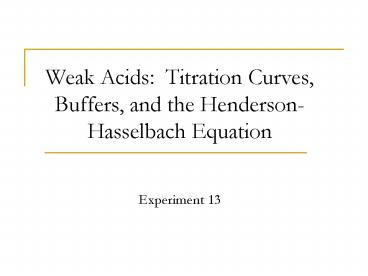Weak Acids: Titration Curves, Buffers, and the HendersonHasselbach Equation PowerPoint PPT Presentation
1 / 32
Title: Weak Acids: Titration Curves, Buffers, and the HendersonHasselbach Equation
1
Weak Acids Titration Curves, Buffers, and the
Henderson-Hasselbach Equation
- Experiment 13
2
13 Weak Acids Titration Curves, Buffers, and
the Henderson-Hasselbach Equation
- Goal
- Use titration pH curve and melting point to
identify an unknown weak organic acid - Method
- Find nacid, MMacid, Ka and from titration of acid
solution - Find melting point range of solid acid from
melting point experiments
3
Acid-Base Definitions
- Acids
- generate H in water
- H donors
- excess H
- Bases
- generate OH- in water
- H acceptors
- Excess OH-
4
Equilibrium in Water
Small K ? equilibrium favors reactants
5
As H rises, OH- falls
6
H and pH
H 1 ? 100 to 1 ? 10-14 in water pH
1 to 14 in water
7
Relationships
H
OH-
H2O
H gtOH-
H OH-
H ltOH-
Basic solution
Acidic solution
Neutral solution
pH gt 7
pH lt 7
pH 7
8
(No Transcript)
9
(No Transcript)
10
Strong Acids (exp. 7)
- 100 dissociation / good H donor
- equilibrium lies far to right
- HA ? H A-
Before dissociation
After dissociation
Relative moles
HCl H Cl-
HCl H Cl-
11
Weak Acids (exp. 13)
- lt100 dissociation / not-as-good H donor
- equilibrium lies far to left
- HA H A-
Before dissociation
After dissociation
Relative moles
HA H A-
HA H A-
12
Acid Dissociation Constant
- For a weak acid
?amount dissociated
?amount undissociated
10-2 lt Ka lt 10-7 2 lt pKa lt 7
13
Henderson-Hasselbach Equation
Smaller Ka? weaker acid Larger pKa? weaker acid
log(xy) log x log y log(x/y) log (y/x)
For buffer system only considerable HA,A-
14
H, pH and Ka, A-, HA
- A- lt HA ?
- A- gt HA ?
- A- HA ?
? pH lt pKa ? pH gt pKa ? pH pKa
15
Chemical Equations
- 1) Weak acid HA dissociation
- 2) Reverse of water autoionization
16
Chemical Equations
3. HA neutralization with strong base, NaOH
Ka
1/Kw
Kneutralization
17
Strong acid-strong base titrations
- At equivalence point, Veq
18
Weak acid-strong base titrations
pH
- equiv. point
VNaOH
½ Vequiv
Vequiv
19
Differences in pH curves
20
Buffer Characteristics
- Contain relatively large amounts of weak acid and
corresponding base. - Added H reacts to completion with weak base, A-.
- Added OH? reacts to completion with weak acid,
HA. - pH is determined by ratio of concentrations of
weak acid and weak base.
21
Key points on the pH curve
- 1) ½ Vequil
- 2) Vequil
22
Molar Mass of HA
- Using titration data
And mass of HA used (analytical balance)
Find molar mass of HA
23
Part 1 Preparation of Acid Solution
Dissolve solid acid
- Use 0.3000 g acid (record acid )
- Dissolve
- a 20 mL alcohol /80 mL H2O
- w 100 mL H2O
24
Part 1 Titration Curve of HA with NaOH
- Record M NaOH MNaOH
- Add NaOH
- up to pH gt 11
- Record pHmeter pH
- during titration
- Two trials
- Draw pH curve
- Calculations nHA,pKa,MMHA
NaOH titrant
Acid
25
Part 2 Melting Point Determination
- TAs will instruct how to do this in lab
- Each sample can only be melted ONCE
- Record melting range
- 132 138C Tfirst liquid to Tall
liquid - or 120 126C
26
Data
- Find ½Vequiv ,Vequiv from pH curve ½Vequiv
- Vequiv
- Determine pKa from ½Vequiv pKa
- Determine nHA from Vequiv nHA
- Calculate MMHA from nHA and massHA MMHA
- Identify HA from table
- Use molar mass and melting point HA
27
Table of possible acids
28
Example Titration Curve
- ½Veq 8.6 mL
- pH 3.5
- pKa 3.5
- Veq 17.2 mL
- pH 7.8
- nHA 1.710-3
29
Example Data
- And suppose at ½ Veq pH 3.5 ? pKa ? 3.5
- Veq pH ? 7.8
Consistent with acetylsalicylic acid
30
Does neutralization go to completion?
HA neutralization with strong base, NaOH
Ka
1/Kw
Kneutralization
Goes to completion (107 lt Kneutlt1012)
31
Report
- Abstract
- Results including
- Titration curves
- Molar mass of HA, pKa, Tmelting
- Identify acid
- Sample calculations
- Moles OH-, moles HA
- Molar mass of HA
- Discussion/review questions
32
Example from text

